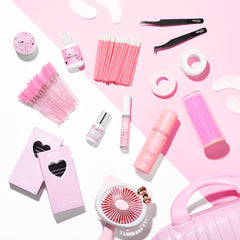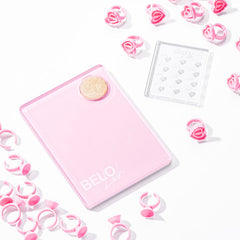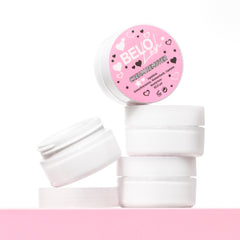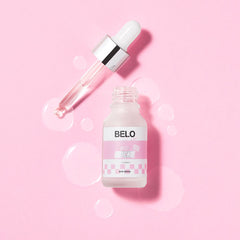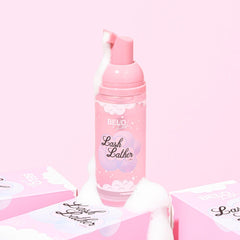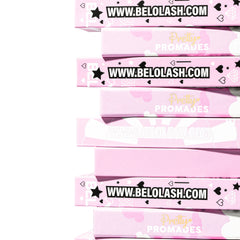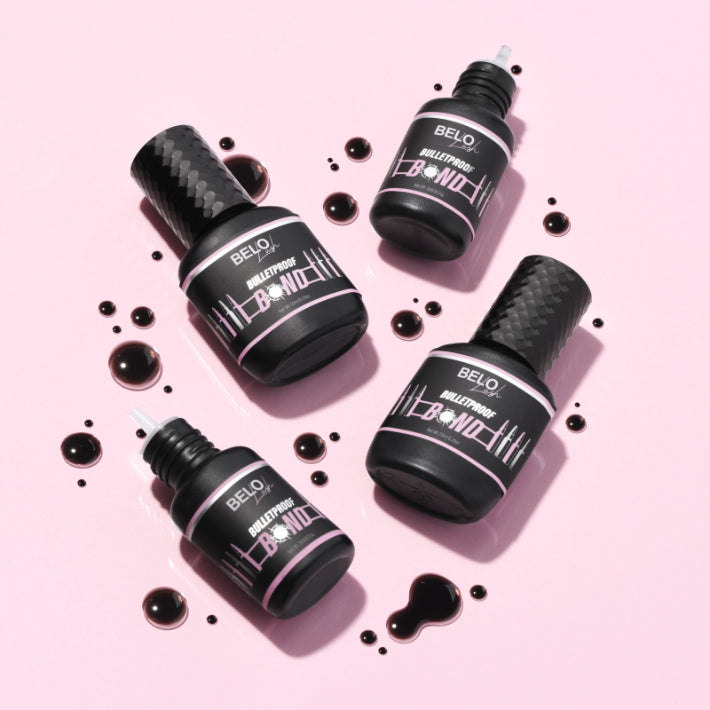Shock! Horror! There’s nothing worse than eyelash extensions that set faster than you’re able to apply them. Yes, we’re talking about shock polymerisation, also known as shock curing.
Shock polymerisation occurs when lash glue cures and hardens too fast due to certain environmental or chemical factors. This unfortunate issue can cause rapid curing, poor lash bonding, clumpy lashes, and messy, unsatisfying results.
But that doesn’t mean there aren’t ways to fix it!
Learning about this unideal phenomenon and how to avoid and fix it can help you elevate your lash game to the next level and deliver gorgeous, long-lasting lash results to your clients—soft, symmetrical, and perfectly cured—every time.
To help you stay out of sticky situations, we’re taking a closer look at shock polymerisation in lash glue and its impact on eyelash extensions. We’re also going to outline the causes of shock polymerisation and provide tips on how to avoid it. Let’s get *stuck* in!
What Is Shock Polymerisation In Lash Glue?
If you’ve ever found yourself wondering, "What is the white stuff on my eyelash extensions?” you wouldn’t be the first.
Dark lash glue turning white is one of several signs that your eyelash extension adhesive has become a victim of shock curing, a chemical phenomenon that occurs when there are sudden fluctuations in temperature or humidity. This rapid curing means that the lash glue hardens too quickly, and if you aren’t done setting your lashes perfectly yet, this rapid, unexpected curing can be a big problem.
Knowing what’s in your lash glue can help you understand why shock polymerisation occurs. There is a high volume of cyanoacrylate molecules found in eyelash adhesive, and when those molecules are exposed to sudden moisture or warmth, they seize up, causing shock curing.
Both of these things negatively affect lash application and retention, either causing clumpy, wonky lashes or poorly bonded ones—a nightmare for both lash artists and clients!
The Causes Of Shock Polymerisation: Why Shock Polymerisation Lashes Occur
Understanding why shock polymerisation lashes occur is important for every lash technician. Once you know why it happens, you can approach lash adhesives with elevated expertise and an even better strategy for creating fabulous, neat, and firmly bonded lashes.
These are the things to watch out for when applying lashes so that you avoid shock curing and prevent the cyanoacrylate in your lash glue from turning white and clumpy:
Improper lash glue storage conditions
You can always tell a lash artist by the way they store their lash glue! If your lash glue collection is not properly stored (such as being left unsealed, stored in a warm place, or left exposed to the sun), it can activate the cyanoacrylate molecules and increase the likelihood of shock curing.
Here at BELO Lash, we have the perfect solution: our Airtight Adhesive Container. This container—capable of holding three bottles of lash adhesive at once—is designed to keep your eyelash glue fresher for longer thanks to its clever airtight design. It prevents exposure to sunlight and moisture, ensuring your adhesive remains in top working condition.
Sudden change in temperature
It’s always best to perform eyelash extension applications in a room with a cool, controlled temperature. Too much heat will cause shock polymerisation, and too much coldness will prevent your adhesive from curing at all.
Setting lashes outside exposes you to too many sudden changes in temperature (and the wind or rain won’t help!). Lash glue is extremely temperature-sensitive. The best temperature range to apply lash extensions in is 20-25 degrees Celsius.
Too much moisture
Moisture and lash glue don’t really see eye to eye. When they come into contact with each other, the glue tightens up too quickly.
The only times moisture and lash glue may come into contact are if a client’s eyes start watering or you start to wash your client’s lashes before all of the glue has been removed. Either way, shock polymerisation is likely to occur.
Practical Tips To Avoid Shock Polymerisation
As frustrating and annoying as shock polymerisation lashes are, they aren’t the end of the world—there are ways to avoid them. Here are our top tips for preventing shock curing:
Proper adhesive storage
Knowing how to store eyelash glue correctly is crucial! Investing in high-quality lash glue is one thing, but without a proper storage technique, your adhesives may become vulnerable to shock polymerisation.
The general rule of thumb for adhesive storage is to place your bottles upright in a cool, dry, and secure place. Always seal them properly after using them, and if they get a bit gunky, use nozzle wipes to keep the nozzle clean. Care is key!
Optimal room conditions
Make sure the environment in which you apply your lashes in is conducive to your lash glue setting at the appropriate pace. That means using an indoor environment with even temperatures and no excess moisture, such as a humidifier, unless it’s needed to regulate the room’s humidity.
Most adhesives detail what humidity they work best in, so you can check this, too. You’ll find that many glues are designed for humidity ranges of 55-65% or 60-65%, so do your homework!
It’s also helpful to choose a lash application studio or room that is consistently clean, organised, and sterile. This way, you know you’re applying your client's lashes in an ideal environment.
Learn the correct application techniques
Since one of the most common causes of shock polymerisation is watering eyes, learning how to apply lashes in a sensitive and professional way is naturally a great method for preventing this rapid curing from occurring.
Taking a professional eyelash extension course and gaining plenty of experience can help you expand your knowledge of lash adhesives and learn the correct application techniques for firm setting, clean applications, and moisture-free adhesive usage.
Use high-quality lash glue
Using the highest-quality eyelash glue is one of the simplest and best ways to ensure that shock polymerisation stays respectfully away from your lash application sessions.
The higher the quality of the lash adhesive, the less likely it is to succumb to shock curing and the easier it will be to give your clients the beautiful, well-set lashes they deserve. It also means generally easier lash management and more consistently stunning results every time.
Here at BELO Lash, we offer top-notch lash adhesives that cater to various lashing styles and needs:
-
Bulletproof Bond Adhesive: With a 1-second cure time, Bulletproof Bond lash adhesive is perfect for experienced lash technicians who can apply extensions to natural lashes swiftly. Suitable for all lash extension treatments—Classics, Russian volume lashes, and mega volume—this adhesive promises incredible retention.
-
Bulletproof Max Adhesive: Offers a super fast-setting time of 0.5 seconds and has a super thin viscosity, making it ideal for advanced lash artists. It ensures fast curing and speedy appointment times for both classic and Russian application.
- Bestie Bond Adhesive: Known as the beloved sister to our bestselling Bulletproof Bond and Bulletproof Max glues, Bestie Bond features a 1-2 second drying time. Its formula is extra strong, giving you a few extra seconds to place the extensions perfectly. This adhesive is suitable for both classic and Russian volume lash extension applications, bonding volume fans just as effectively as individual lashes.
With these options, you can find the perfect adhesive to match your skill level and application speed.
Choose an adhesive with the right drying time
Different adhesives have different drying times. Some are ultra quick at just 0.5 seconds, while others are more forgiving and take between 1 and 2 seconds. If you are a new lash technician, you may need that little extra to get everything in place, so pick the adhesive that sets in a time that suits you!
Once you’re a pro and can work fast, a lash glue with a quicker drying time will be your bestie.
Conducting thorough client consultations
Client consultations are crucial for creating beautiful, long-lasting lash extensions. During a client consultation, you can walk your client through the upcoming process and explain what to expect, preventing movement or eye-watering in advance.
How To Fix Shock Polymerisation
So, we now know how to avoid shock curing, but how do we fix it when it unavoidably occurs?
Unfortunately, shock polymerisation is very difficult to reverse, and the only way to fix it once it has happened is to remove the affected lashes, gently but thoroughly clean up the residue, cleanse the lash line, and reapply a fresh set of lashes.
Once the cyanoacrylate molecules have been exposed to moisture or humidity, there’s no going back—they need to be discarded and restarted for the best results. This can be frustrating in the moment, but ultimately, it’s the best way to fix shock cured lashes and restore symmetry.
Investing in essential lash glue accessories is another way to expand your kit and gain access to the necessary tools for fixing these problems as they occur. With the right accessories, you can keep your adhesives in good condition and apply them quickly and correctly without landing up in sticky situations!
The best thing you can do is educate yourself on how to avoid and fix this common issue—which, by the time you’ve read this blog, you’ve already taken the first step towards!
Stop The Shock!
Lash application is a complex cosmetic art that requires a range of technical, creative, and sometimes even chemistry-related skills.
Shock polymerisation is a fairly common issue, but there are lots of ways to avoid it from happening and fix it when it does occur.
Even the most experienced and professional lash artists can encounter shock polymerisation from time to time, so don’t lose heart if the dreaded chemical reaction happens to you. Use this guide to enhance your adhesive knowledge and keep your lash applications shock-free!


